 
|
||||
|
|
THE BREAKERS |
|||
|
The long time Breakers line-up of Jim Abrahams (guitars), Marc Lockett (drums) and Jayson Slater (bass) sound in tremendous form throughout and, with its significant helping of 18 new tracks, this classic Breakers album draws upon the band’s high energy psychedelic instrumental rock power with every cut a classic. The album also features the first-rate horn section duo of Dan Klapman (saxophone) and Gary Kretchmer (trumpet). A Seahorse Of A Different Color starts off in a characteristically strange Breakers manner with a remote-sounding track called “Salute”. Sounding more like Jimi Hendrix than ever, this classic Breakers track sets the stage for the album to come. Kind of like the album’s overture, “Salute” clocks in at a brief 2:18, with an Aztec death whistle, ascending psychedelic guitar and a little bit of screaming leading us into “Monster Storm”. For Breakers fans, “Monster Storm” is where the rubber meets the road, with the band’s patented, hard-driving beat accentuated by the pounding drums of Marc Lockett and the pulsing bass beat of Jayson Slater while Jim Abrahams’ vibrato guitar sounds like a Farfisa organ locking into the horn section, further punctuating the staccato beat. Never let it be said that the Breakers don’t have a sense of humor, especially regarding their way-out song titles, and that is evident upon hearing the track “Escaping Through The Window”. Here a more customary surf-rock stance is taken by the band, with a highlight being Jim Abrahams’ pizzicato plectrum picking out the tasty chord changes. Another exciting rocker, “Landmark” maps out a stock, although quite up-tempo, psych-surf instro beat. Midway, horns also kick in providing another edge to this striking Breakers number, an homage to one of the band’s local hangouts.
“El Traditional” is a lively tune, with the Mariachi horns picking things up in its last couple minutes. True, traditional though it might appear, with the Breakers no direction is ever set in stone making the song yet another highlight of A Seahorse Of A Different Color. “BagPipeline” is certain to stir up discord and/or intrigue among diehard ‘surf-music’ purists. The Breakers are possibly the only band on Earth that would consider adding the superbly played Scottish bagpipes of Neil Hanson to what is commonly referred to as the holy grail among the catalog of instrumental guitar classics. More than just a novelty cover, the Breakers effectively approach “BagPipeline” with an adventurous, humorous and cheeky spirit, all at the same time. With its reflective, melodic cadences, “Teardrops” is another Seahorse highpoint with Jim Abrahams’ lead guitar interlocking with the Breakers rhythm section, plus a synth-sounding overdriven guitar chiming in the distance. The horn section kicks in with some tasty harmonic accompaniment turning “Teardrops” into a kind of instro-rock reverie. Halfway through the album, the guitar-driven rocker, “Garage Door To Your Mind” deals us yet another typically offbeat Breakers title with some eerie, theremin-like keyboard sounds courtesy of Jim’s guitar paraphernalia, pulling the band in another otherworldly direction. If the 18-track A Seahorse Of A Different Color was divided into two halves, this track would open side 2 in style. Track 10, “Seamhead” is one of the truly powerhouse tracks on A Seahorse Of A Different Color. Relentless in its sonic fury, “Seamhead” pushes the band into an absolutely dominant direction. The epitome of the Breakers potent approach to “surf-rock” comes alive on “Seamhead” and it’s not to be missed. For die-hard Breakers disciples, track 11 “Houses Floating Away” represents The Breakers at their most progressive. On “Houses Floating Away” The Breakers prove themselves to be modern day experimentalists. One might think this track is a large, keyboard synth track but most of it is electric guitar played through a range of guitar effects and pedals, including Jim’s favored mellotron pedal and esoteric echo treatments that evokes a near King Crimson terrain, as defined by a guitarist coming from a psych-surf background. The same sonic reinvention adopted on “Houses Floating Away” continues on “MoonBase Alert”, yet breaking away from the track’s sizable introduction, the up-tempo hard rock edge moves us fast into modern-day instro-guitar rock. “Sharks In The Streets” lives up to its ominous track title and, packing a punch with its exciting fretboard guitar riffing, the track comes as close as it gets to a tried and true instrumental guitar rocker, albeit from a Breakers perspective. Another key track on A Seahorse Of A Different Color, “Skeleton Invasion” provides a perfect example of The Breakers approach to what some might call psychedelic-surf meets prog-rock, taking a Halloween ritual, scary sound effects and all, and turning it into a Gothic instrumental with Jim’s mellotron guitar effect giving the track its neo-prog edge. “Rammer” takes the Breakers back to neutral, if not completely safe terrain. A real pumper of a rock instrumental packed with straight-ahead guitar riffing, the track offers extra penetration thanks to the well-placed Mariachi style horns.
Track 17 is quite possibly going to be the most-played track on A Seahorse Of A Different Color as it features The Breakers instrumentalizing the 1969 classic by the fabled West Coast hippie-rock band It’s A Beautiful Day. The track here, “White Bird”, composed by the IABD founder David LaFlamme and his wife Linda, was played constantly by FM DJ’s coast to coast back at the end of the 1960s and well into the dawn of the 1970s. With its melody played faithfully, sans vocals, The Breakers give “White Bird” a respectful instro, surf-rock treatment. Not to be missed is the video for the track, which, in a twist of fate, features the Breakers’ cover version played over clips of Alfred Hitchcock’s 1963 film classic The Birds. The interplay between the core Breakers lineup, with friend of the band Jeff Bond sharing guitar duties with Jim Abrahams on this cover, is beyond reproach. A Seahorse Of A Different Color goes out with a bang. 18-tracks in, “Internal Sun” is almost scalding in its intensity and gives new meaning to the surf-influenced instrumental realm. A Seahorse Of A Different Color might not be tailor-made for every surf-instro fan. Those of the pious musical nature among us, who prefer clean-cut images and the purist innocence of the early 1960s sounds of The Ventures and The Shadows, might be in for a jolt. With A Seahorse Of A Different Color, expect the unexpected and your ears will never quite be the same again.
mwe3.com presents the 2024 interview with
Jim Abrahams: I was in a minor car accident that nonetheless managed to break my right wrist pretty badly… right when we were just about to go back into the studio. It turned out that I needed reconstructive surgery for broken bones and torn ligaments, so that definitely slowed things down. It did make for some extra time to write, evolve the songs and think about the album flow, and probably resulted in a longer recording than we originally planned, as a result. Mainly, it was just frustrating and delayed things though! The original idea was to record the album early in the year and play out after that, but the accident pushed the recording into the rest of the year, as we got into the summer, everyone had family and work responsibilities picking up, and I was still going through rehabilitation, which took me a good six months or so after getting out of the cast. As a result, we only played out a few times last year. mwe3: Tell us about the 2024 Breakers album A Seahorse Of A Different Color and when it was written and recorded. There are 18 new track songs the album, are they all newly written and recorded? Jim Abrahams: It was written partially late last year, and partially this year. We have a basic approach, where I’ll bring some basic song ideas into practice or the studio, and we’ll very often change the riffs, add to the feel or try different parts in different places, which is easy to do, because I usually don’t write very complicated stuff! And the guys have ideas for their parts that end up evolving the songs. The songs usually have a groove, parts or tones that evokes, at least to me, certain feelings, visuals and song title possibilities. On much of the album, I used one of a couple of Fender Stratocasters with Fender Original 1957 / 1962 SSS pickups, with one of the tone knobs modded to be a blender knob. That knob allows the blending of the neck and bridge pickups, which gives it a lot more tonal variety. The guitar on this one also has a Vega-Trem installed, maybe my favorite tremolo bar setup.
Jim Abrahams: The title track felt a little bit of an undersea scene, a little psychedelic, maybe, and that led me to the title, which is a play on the old saying, “A horse of a different color”, as I think our stuff has some variety to it, and this was, to me, a little bit of a different kind of track. I had, along with that, the idea of seahorse who had just defended his territory, and the idea of commissioning something to that effect in black-light colors. One of our main artistic compadres, Mark “Topes” Thompson, absolutely nailed it right out of the box. As usual, we had our adjunct band members on horns, and maybe on more songs that we felt could take a horn part than ever before. That’s Dan Klapman on sax and Gary Kretchmer on trumpet. Gary also had to go through a stem cell transplant this year, so I got off light with the wrist injury. We had Neil Hansen on bagpipes, on “BagPipeline”. Aside from being a great bass player in the local band Bam Jand, he and the other guys in that band are all competition bagpipe players. So that was something unique. Our buddy Jeff Bond, who also shared guitar parts on our cover of “Tubular Bells”, also guested on “White Bird” and “Internal Sun”, and our producer, Craig Williams, added some keyboards to “Luck Favors The Prepared” at the very end of the whole process. Craig handled all of the recording, engineering and production duties most excellently, as he always does, and he often suggested slight adjustments that made a world of difference. That’s the advantage of having such an experienced producer at hand. Craig has worked with the likes of Styx, Dave Mason and others. Mark, as I mentioned, did the art, as he has done so aptly for us before, as well. mwe3: The lead off track is called “Salute”. It’s drenched in reverb and it almost sounds like a Jimi Hendrix inspired moment. How did you mastermind that track?
I put it on a table in the studio, and played the melody with an E-Bow, which was about all I could do with my right hand, at that point. I played that through an EP Booster pedal, plus a little bit of echo and reverb. I thought the middle should be like a rave–up, where we had kind of a monstrous guitar sound, like the skies were opening and the ritual was bringing in a ton of chaos. I just did that by adjusting the effects a little bit and scraping the strings with my guitar tuner. We added an Aztec death whistle, which just creates a horrendous sound, to that. At one point, I stepped outside and came back in to see Jayson in front of the microphone. I said, “I don’t know what’s going on here, but I think I’m going to like it!” Craig said that he felt that the song needed some screaming, so Jayson added the screaming to good effect. Anyway, that was the general idea; it’s a pretty cool opening sound experiment. mwe3: “Salute” leads into “Monster Storm”. Is that a more traditional sounding Breakers track? What is the instrumentation lineup on “Monster Storm”? It really evolves, keyboards, horns and all. It’s a brilliant stroke of genius. Jim Abrahams: That one was originally just a straight-ahead 3-piece retro reverb tune with a kind of phase effect to get a kind of “Telstar” kind of vibe. We recorded the track, and then had the thought to bring the horns in on it, especially since Gary was going to be on the shelf for a while with the transfusion protocol. I wasn’t convinced that it should have horns on it at first, but then we said, what the heck, why not bring the guys in on it and give it a shot? If the horns don’t work, we can always release it without them. Gary wrote a great horn part for Dan and himself, and it really took the song up a notch. I can’t imagine it without them now. So it ended up being myself, Marc, Jay, Gary and Dan on that one. mwe3: “Escaping Through The Window” is another more traditional sounding surf-rock track even if the title is anything but traditional. Tell us about your guitar picking style around the 1 minute mark.
So it is supposed to give the feeling of gearing up to go out running on an adventure, something new, or something you’re not necessarily supposed to be doing. That middle section is supposed to feel like a sense of excitement and wonder. I just switched from the neck to the bridge pickup added some finger picking there, and kicked in a more spatial reverb, in, with a little Rotovibe type treatment, to get that feeling. You could take that into anything further on in life – gearing up to go jump into something new, and having the presence of mind to feel the excitement. On this one, I used my Strat with the David Lozeau art that we used for the cover of our Voodoo Treatment album. mwe3: Track 4, “Landmark” is interesting sounding too. Is there a story behind the title? The horns come back into the sound on “Landmark” and the trumpets give the track a Mariachi type sound, and what are yelling at the end? Marc Lockett: I brought it up to Jim. Why not do a song for here and El “Tradicional”. We went back and forth with the music and title, but we did find the sound we wanted for the song. Jim Abrahams: That is a tribute to one of our favorite hangouts, The Landmark Inn, in Northbrook, Illinois. It is right by the studio, and Marc, Dan and I live pretty close to it. They do not usually have live music, but we’ve played there a couple of times, once indoors and once outdoors, with a 30 foot inflatable screen that we were projecting old Godzilla movies, surf scenes, psychedelic stuff and the like. It is our go-to place in the area. We wanted to spotlight Dan and Gary, once Gary was able to bounce back and record. After the guitar, Dan lets it rip on sax, followed by Gary on trumpet, and then both of the guys together. We wanted it to convey the lively atmosphere and good people there… it really worked well. That is our buddy Constantine, who is the co-owner, is the guy yelling “Last Call!” live at the end of the night, with the bar noise that Marc and I recorded in the background. We love the place, the people who run it, and our friends who go there for football or a quick bite after work. All cool. It’s funny, I am there right now, as I’m thinking about some of the interview questions.
Jim Abrahams: Yeah, that was going to be the centerpiece, obviously. We wanted that to sound kind of majestic and a little psychedelic, but rooted in the basic driven reverb sound, although it’s probably not such a “traditional” surf tune, with a build-up to get that rousing feeling. I used my Fender “Splattercaster” for that. I wanted that to sound like the picture I had in mind for the title and album art, which again, Topes really nailed! mwe3: “El Traditional” has a Latin feel. How would you describe that one? Marc Lockett: I had the idea to do a Latin drum feel to start it off. A small nod to our brothers at El Trad, like Landmark, we enjoy going there also. I kind of wanted to push the drums in a different feel for this one, the intro part… we have never touched that feel yet. Jim Abrahams: That one is the other homage to a local hang. We have another place that we patronize a lot over here, a favorite restaurant in Glenview, Illinois about 10 minutes away from The Landmark, El Tradicional. The have literally the best sangria I have ever tasted, and I have had a lot of sangria! I think this was the first one that Gary tried after coming out of his spinal transfusion protocol. He didn’t know if he had his wind back fully enough to play any more parts; I said, that’s OK – I’ll fill the spaces we held for guitar parts, but a few of them, particularly “El Tradicional”, will sound much better if you feel up to it. He called me back the next day and said, “You know what? I’m going to take this as a personal challenge to push myself to get some parts done for this.” Not only did he hit the ball absolutely out of the park on this one, but he filled ALL of the spots we were holding for potential trumpet or full horn parts! That meant more horn parts where there would have otherwise usually been guitar, so less playing from me, and a better result, as well. He recorded his parts at home, where he had to remain remote while his white blood cells regenerated. mwe3: But of course “BagPipeline” is very unique in that it adds Scottish sounding bagpipes to the usually straight-ahead style of possibly the most well-known surf-rock track of all time. How did that one come together and who adds in the bagpipe sounds? Is that a good example of the way “The Breakers take traditional surf concepts and hit it out of the park.”
Jim Abrahams: That one started out as a little play on words, obviously, but we happen to know the jam band, Bam Jand, as I mentioned earlier, where each of the guys is a competition bagpipe player. They are actually the guys who shared the bill outside with us at the Landmark; the other time we played here was with the well-known Chicago surf band The Cocktail Preachers. At any rate, we asked Neil, who I mentioned earlier, if he or all of the guys would like to play on this. It was much easier to organize for one bagpipe, and it is a pretty tough and restrictive instrument to play. We recorded the song, then brought Neil in to overdub the bagpipe parts in a way that would fit the original classic song… and bend it a little, lol! mwe3: “Teardrops” takes the Breakers style into new directions. It’s a sad melody, but it is also majestic, especially with the horns. Is it a sad song you wrote for someone and what about your guitar sound on that track? Sounds like you’re reaching for the sky. Jim Abrahams: We wanted it to be a sort of somber song. Sort of slow and pensive at the start, basically a chordal song, with the end being taken up by the horns. Sort of like a Chicago or Blood, Sweat & Tears song. Which is funny, because I’m listening to “25 or 6 to 4” on the jukebox at The Landmark right now, as I’m going through the questions. The song is an homage to our friends and family members who have passed away, and taking the time to think about the memories we have with them, back to childhood. This one is particularly dedicated to my dad Bob and my cousin Matt, who both passed away last year. A lot of heavy, but great memories. We opened the last album with a similar concept with the song “A Trip Through Life”, which was built on a similar concept. The basic guitar part is underscored with another E-Bow – type part at the start; we wanted the horns to sound majestic, so after Mark kicks in the at the end, the horns take over. The tone on the guitar is rolled off and it’s mixed expertly by Craig under the horns, so it almost sounds like another horn part. This is the other song we recorded, along with “Monster Storm”, when we had a little space after my wrist healed and before Gary’s procedure. Both were released as a kind of double-sided digital single earlier in the year. I used a Strat that I had painted in a black sparkle finish with a cool glow in the dark galaxy pickguard that I use live quite a bit. mwe3: “Garage Door To Your Mind” does have a kind “garage rock” element but there’s also some wild keyboard sound double the guitar melody and that closes the track. The track borders on psychedelia. Jim Abrahams: Yeah, that’s what we were going for, exactly… a 2-minute slice of instrumental garage rock psychedelia. Marc’s drums are great on this, they really carry the song as they usually do, and Jayson rides the rhythm rock-solid. That keyboard sound is actually guitar, through a synth emulator pedal that I occasionally use for specific parts and I kick in a sitar emulation during at a couple points. I always try to utilize outboard effects that I can use live but having space on the pedal-board, aside from the usual spring reverb, gets tough at times from a real estate perspective! mwe3: “Seamhead” goes in a range of musical directions. It sounds like The Breakers breaking new ground. What guitar sounds are you flavoring the track with? Jim Abrahams: It’s funny, that is actually a straight ahead guitar into a reverb tank, with two adjustments. The reverb is just mixed up a bit, and it is proceeded by an echo effect that I installed into my delay pedal. It incorporates some Rotovibe-type effect, which is triggered by how hard the string is hit. It’s a little hard to control, but it worked out great! The name refers to someone who is a baseball nut, but also sounds like a reference to the Frankenstein monster, so it all works! We will certainly play this one live, and get a good video highlighting some MLB greats with this. It may end up being a little Chicago Cubs-centric, hahaha.
Jim Abrahams: So, there is a story behind the titles to three of the songs. Marc, Jay and I came over to The Landmark – again – you might be detecting a trend here - after practice one night and saw a story about Hurricane Ian in Florida. The headline on the news on TV said, “Monster Storm. Sharks In The Streets. Houses Floating Away.” We both said, “ Shoot, that’s three good song titles, if we can come up with some stuff that sounds like those should feel.” Sometimes, it just happens like that. We usually have a ton of song titles in the hopper, but that was pretty cool way to find three more. For this one, we had the idea to do something really atmospheric and experimental, that felt like everything floating away, under water, and periodically coming back into focus again. It was pretty free-form. I have an added atmospheric echo on this, with some pitch effects and backwards guitar turned way up in the mix. Jayson uses a reverse delay on bass midway through, and Marc adds some percussion accents with cymbals, and the scratching noise he is using jazz brushes on the snare for that sound, for added atmosphere. We just kind of went with the flow with this one. And yes, I have the main guitar part going through a mellotron pedal, and then a more spatial reverb, before the usual spring reverb. There is also some pitch shifting in there, on the guitar. When Dan enters with the sax, it adds the perfect, ascendant atmosphere; he plays a great part, there. This one, we wanted to record in a way that would give us a lot of room to free-form it live, which we can’t wait to do. The last song we took this approach with was probably “The Owls Are Watching” on our first album, Transmissions From A Hornet – Free Environment, which was based on a riff that Jay came up with. That ended up being a one-take thing in the studio. Craig asked, “How did you guys feel about that?” I said, “I don’t know, I think we might be able to do better.” To which he responded, “I don’t know – I think you guys ought to come in and listen to this one.” Same approach, with a little longer and less-structured piece, here. mwe3: “MoonBase Alert” picks up from where “Houses Float Away” leaves off yet it gains traction as a guitar rock instrumental. It’s kind of a dark track and it’s also the second shortest track on the Seahorse album. The guitar sounds are brilliant. Jim Abrahams: I wanted that to sound like a call for help from a distant off-planet base. So the initial guitar sound, I thought, had to be kind of overdriven and granular-sounding, like a broken up signal being received from outer space. And it had to be kind of a melancholy line, like there was some kind of issue and a hopeful, but resigned call for help. This was originally going to be a solo guitar piece, but the intro percussion and ascendant parts the guys played, made it much better and more emotional, not surprisingly. Marc’s drums really build it into an epic, and Jayson’s idea to repeat the main guitar part delayed a bit on bass is really cool. I think we might be playing this one out live one soon.
Marc Lockett: I never thought of it as a heavy song. I just felt it needed a harder hit to bring out the other guys. Jim Abrahams: That’s an interesting thought. We just wanted that to be like a straight-ahead rocker that sounded as aggressive as its title. On that one, the guitar was my Entwistle Martin Cilia model, which is a great guitar. Martin is a great guitar player, and his work both solo and with the latter day Atlantics a big influence, although you probably wouldn’t be able to tell that, offhand. I think the guitar might be the first one in the U.S., if I remember correctly. mwe3: Another highlight of A Seahorse Of A Different Color is the ominous sounding “Skeleton Invasion”. We know your fondness for Science Fiction. Is “Skeleton Invasion” planned for one of your future videos? What is the instrumentation, guitars, effect, overdubs on “Skeleton Invasion”? Jim Abrahams: Yes, we actually just did a video for “Skeleton Invasion”. We wanted to make sure one of the songs was kind of a spooky Halloween song that we could return to each year. We had originally planned to have the album done way before Halloween, before I broke my hand, and this was one of the first ones that we started in on. We returned to it periodically over the year to build it up, and this one also has the Mellotron effect on it prominently. Marc had the idea to start the song with chains being dragged, and keep that going throughout the whole song. Craig’s studio is known as Dr. CAW Recording, and he uses the “crow” noise that is in there to alert him when he is getting messages, so we included that, as well. Our buddy Mike has literally the best werewolf howl we have ever heard come out of a human, so we got him in there a few times, as well. It's like an old–time sound effects record. mwe3: “Rammer” is another aggressive sounding and titled track that is relentless in its sonic drive. The horns that click in add another layer to the sound. Mariachi Surf? Marc Lockett: This was a saying of Jim’s dad, Bob… a little nod of the hat. Jim Abrahams: Gary wrote another great part that he and Dan nailed! This one is a straight–forward pounding tune that sounds like its title. I used the Lace “Teliki” guitar on this one. I purchased that at this year’s Surf Guitar 101 Fest from Lace Music Products. It is something else both sonically and visually! I brought it as one of two guitars to use at the Third Coast Surf Fest this year, and meant to leave it on a stand as a stage ornament for most of the set, then switch to it for the last song or two. I ended up having to play it the whole set after busting the A string on my main guitar about 10 seconds into our first song! The guitar is equipped with humbucking pickups, which I usually stay away form, but they are custom – voiced perfectly, like high-powered single coils. mwe3: “Luck Favors The Prepared” has a cryptic title and the song changes tempo into a kind of swing-surf sound. There’s also some cool keyboard sounds, sounds like a Farfisa? Does the organ sound double the guitar lead? Tell us about the song, title and the organ sound.
Marc Lockett: I had wanted to incorporate a jazz thing for a long time. I really just needed the right song. That little jazz part is for my Nana and Papa; Jay and I were in Oakton Community College Jazz Band like 20 years ago – he knew exactly what feel I wanted for that part. We likely have more of this ahead of us. Jim Abrahams: This is one where we had the song before we attached the title to it… it is a saying that my dad used to have; I thought it kind of sounds like the “A” part sounds like preparation, and the “B” part sounds like, “Go get done what you’re planning to get done”, so it kind of fits. mwe3: Even younger surf-rock fans must know the song “White Bird”, that was made famous by the San Francisco band It’s A Beautiful Day back around 1969. It’s such a natural sounding song for The Breakers approach to surf-rock and guitar instrumental tracks. Also the YouTube video is great, with its use of footage from the Alfred Hitchcock movie “The Birds”. Who directed and edited the “White Bird” video? Jim Abrahams: We had the idea to do a rocked-up version of that. It has such a classic melody, and no one had done an instrumental cover of it, surprisingly. We came up with the base arrangement pretty quickly, and our buddy Jeff Bond, who is a great guitar player, guested on it. Marc really drives heck out of this with his drumming. It was a blast to knock out, and should be fun to play live. Regarding the video, I spent some time editing it down to the song. I had the idea to pair the two when we first started talking about covering it. I got focused one night and spent, I think, about 3 hours or more editing that down. That one is not for the faint of heart, hahaha! mwe3: “Internal Sun” closes out the album with another powerhouse track that infuses psychedelia with garage rock sensibilities. It has a kind of Black Sabbath effect and in fact, the whole album is basically a guitar lover’s dream come true. Marc Lockett: Those drums just had to line up with the guitar rhythm. The accents remind me of something from the 1980’s / 90’s rock sound that I was listening to back at that age.
I used my gold 50th Anniversary Stratocaster on this, and parts of “White Bird”. The pickups have a little more drive to them, which ends to the sonic aggressiveness. mwe3: With so many guitar styles on the album it sounds like you’re planning on reaching as many guitar genres as possible. The Seahorse album is very eclectic. It might scare away the purists but its sheer diversity gives it a much wider potential fan base and new listeners too. What are your plans to break the album and take the Breakers to new and exciting sonic horizons? Jim Abrahams: Well, we plan to be playing out a lot more this year, and maybe we’ll record a thing here or there, maybe an EP that will probably be a little more straightforward and traditional. The traditional stuff is always at the heart of what we do, but we try to make sure to look for ways to expand the boundaries and bring all of our other influences in, as well – particularly with this effort. Hopefully that expands the audience a bit, allows us to tap into our other influences, and introduces a little creative uniqueness that a listener might not hear elsewhere! Marc Lockett: We are very fortunate for everyone who listens to us. As far as future plans with styles and ideas, once when we record, then we’ll know. Honestly, we just want to get out to support and play this new album and see all our fans.
Connect with The Breakers:
|
|
|||
|
||||

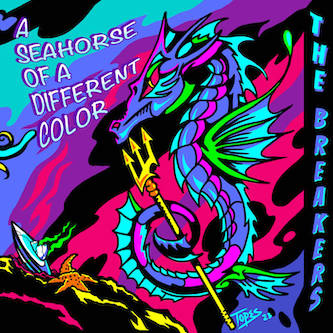 A couple years after they released their CD compilation album Strange Shores: Old Singles & New Hits, Chicago’s instrumental Psych/Surf band, The Breakers are back in action with an all-new album called A Seahorse Of A Different Color. Released on the U.K. based Sharawaji Records label, the 18-track, 56-minute CD features The Breakers in the studio laying down a consistently high level of psych-surf action, providing loads of high-octane entertainment.
A couple years after they released their CD compilation album Strange Shores: Old Singles & New Hits, Chicago’s instrumental Psych/Surf band, The Breakers are back in action with an all-new album called A Seahorse Of A Different Color. Released on the U.K. based Sharawaji Records label, the 18-track, 56-minute CD features The Breakers in the studio laying down a consistently high level of psych-surf action, providing loads of high-octane entertainment.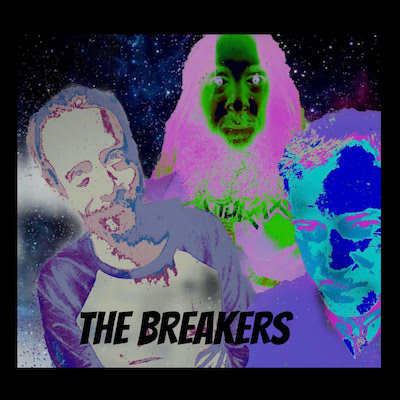 The album’s title track, “A Seahorse Of A Different Color” is a fitting track for this noteworthy album. There is a bit of an ‘aquatic theme’ on the track and Jim Abrahams takes off with some scintillating picking on the upper fretboard registers with the Breakers ultra-tight rhythm section keeping the song grooving along in fine form.
The album’s title track, “A Seahorse Of A Different Color” is a fitting track for this noteworthy album. There is a bit of an ‘aquatic theme’ on the track and Jim Abrahams takes off with some scintillating picking on the upper fretboard registers with the Breakers ultra-tight rhythm section keeping the song grooving along in fine form.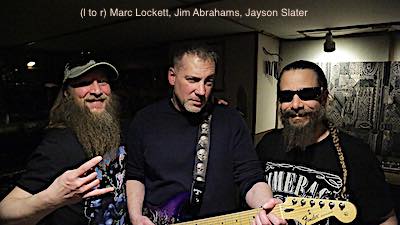 “Luck Favors The Prepared” is a unique track on A Seahorse Of A Different Color in that it features album producer Craig Williams adding in keyboards on what sounds like a 1960’s flavored Farfisa organ. Some cool tempo changes give the mid-section a retro, neo-jazzy influence, driven by the rhythm section of Jayson Slater and Marc Lockett.
“Luck Favors The Prepared” is a unique track on A Seahorse Of A Different Color in that it features album producer Craig Williams adding in keyboards on what sounds like a 1960’s flavored Farfisa organ. Some cool tempo changes give the mid-section a retro, neo-jazzy influence, driven by the rhythm section of Jayson Slater and Marc Lockett.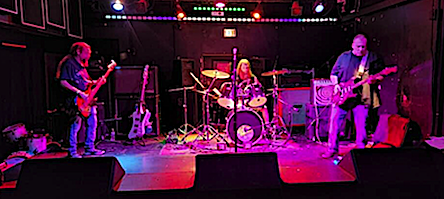 Jim Abrahams: We recorded that when I was still in a cast, actually. I needed to do something even though I was laid up. I had the idea for that melody as like a somber salute, like an old Aztec sacrificial ceremony or something. I used an old Eko guitar, with the tremolo swapped out for a Duesenberg trem.
Jim Abrahams: We recorded that when I was still in a cast, actually. I needed to do something even though I was laid up. I had the idea for that melody as like a somber salute, like an old Aztec sacrificial ceremony or something. I used an old Eko guitar, with the tremolo swapped out for a Duesenberg trem. 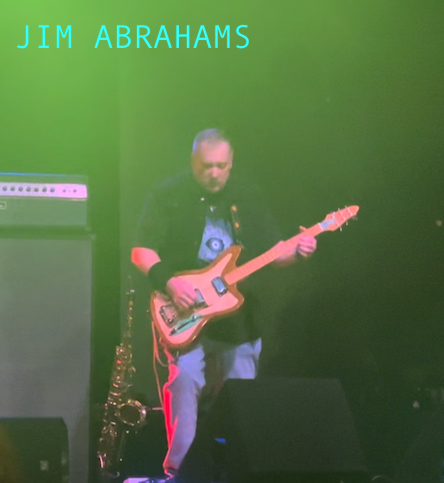 Marc Lockett: Over a year ago, I said, let’s get Bagpipes in our stuff. At first, he was not sure how it would work, now we have this great song.
Marc Lockett: Over a year ago, I said, let’s get Bagpipes in our stuff. At first, he was not sure how it would work, now we have this great song.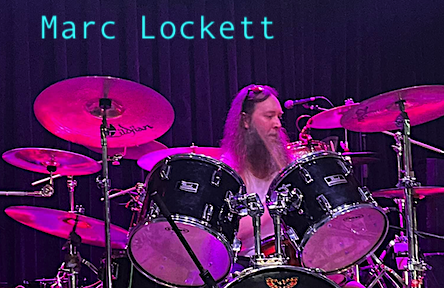 mwe3: Speaking about anything but traditional surf, “Houses Floating Away” has got to be one of the most brilliant tracks the Breakers have done yet. It more like ambient / avant-surf with heavy influences plus the horns too. What about the effects that really add the spacy sounds and are there mellotrons on that one?
mwe3: Speaking about anything but traditional surf, “Houses Floating Away” has got to be one of the most brilliant tracks the Breakers have done yet. It more like ambient / avant-surf with heavy influences plus the horns too. What about the effects that really add the spacy sounds and are there mellotrons on that one? 